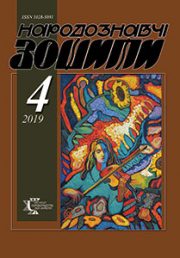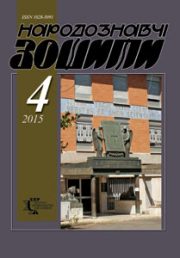The Ethnology Notebooks. 2024. № 5 (179), 1085—1095
UDK 726.1.05(477)”19/20″
DOI https://doi.org/10.15407/nz2024.05.1085
HNIDETS Rostyslav
- ORCID ID: https://orcid.org/0000-0003-1351-4986
- PhD, Associate professor of the Department
- of Architecture and Conservation,
- Lviv Polytechnic National University,
- 12, Bandery street, 79013, Lviv, Ukraine,
- e-mail: rostyslav.b.hnidets@lpnu.ua
To consideration the problems of forming the domical completion of the church buildings, theirs typological and spatial construction varieties that have an influence on the tectonics spatial features in Ukrainian temple buildings. Form, construction and space it’s so much the main means of forming each architectural building and specifically sacral, that is the church. To be since the domes make stand up the accomplished to the high-altitude development in Ukrainian church architecture, the builders of the temples of Ukrainian architectural modern style have made in reality the perfect examples of Ukrainian temple.
The purpose of this research is to identify the regularities of the formation of the bane endings of temple buildings, which have become an inherent feature of the architecture of the Ukrainian church, the formation of the stylistics of these achievements in the church buildings of the Ukrainian architectural modernism on the basis of the architectural and building tradition, and their manifestation in modern Ukrainian temples and temple construction in general.
We can observe that the church building of this period (end XIX c. — 20—30-th years XX c.) differ from the special harmony scale and proportional perfection to concerning of the nieghbouring building and locality. Then constructed in towns and small towns or villages, they were never the appearance of massive block, overloaded of dominants and accents, that we must observe for some contemporary temple buildings. Theirs builders-architects can be able to seek out the optimal to the harmony scale and proportional and perfect make use the place and landscape of the territory for building. Theirs domical completion of all temple buildings make up only to confirmation of their spatial and architectural decision. Also the contemporary forms of domical completion and the bring nearly to the traditional of their expression that as to modern features to forming domes in the structure of contemporary tendency towards the temple buildings.
The intelligence methodology is based on general scientific methodological principles and the main requirements for works of ethnological direction.
Keywords: forming regularity, dome, domical completion, architecture and constructive tradition, Ukrainian architecture modern style, transformation, identity, contemporary temple building.
Received 23.09.2024
REFERENCES
- Lev, Cr., Slobodian, V., & Filevych, N. (2015). 100 churches of Nahirnych. The churches of Evhen Nahirny (Second part). Lviv [in Ukrainian].
- Hnidets, R. (2001). Peculiarities of the dome structure of Halychyna churches in the late 19th century — the early 20th century and their contemporary embodiment in church building. Memoirs of the Shevchenko Scientific Society. The works of commission of Architecture and Urban Planning (Vol. CCXLI, pp. 341—360). Lviv: NTSh [in Ukrainian].
- Tymoshenko, S., & Mychailyshyn, O. (Ed.). (2021). Return. Kharkiv: Rarytety Ukrainy [in Ukrainian].
- Halyshich, R. (2002). Ukrainian church architecture: monumental and decorative art abroad. Lviv: Spolom [in Ukrainian].
- Slobodian, V. (2003). The sacral building architect Roman Hrytsai. Visnyk «Ukrzachidproektrestavratsia», 3, 79—88 [in Ukrainian].
- Noha, O. (1999). Ukrainian style in churches art of Halychyna XIX — the early XX cc. Lviv: Ukrainian Technology; Fabryka Ivana Levynskogo [in Ukrainian].
- Hnidets, R.B. (2000). The construction features of cross-domical structure in Ukrainian churchesof Prince’s epoch (X—XIII century). Visnyk Lviv Politechnic NU. Architecture, 410, 326—332 [in Ukrainian].
- Asieyev, Yu.S., Vecherskyi, V.V., & Tymofiyenko, V.I. (Ed.). (2003). The history of Ukrainian architectur (Pp. 100—173). Kyiv: Technika [in Ukrainian].
- Lohvyn, N., & Tymofiyenko, V.I. (Ed.). (1997). The cross-domical temples of ancient Kyiv’s in context of Middle Ages of Easter Christian traditions. Architecture Heritage of Ukraine (Pp. 51—59). Kyiv [in Ukrainian].
- Lohvyn, H.N. (1968). Through the Ukraine: the monument to the past of art (Pp. 288—296). Kyiv: Mystetstvo [in Ukrainian].
- Pavlytskyi, H. (2017). Wooden and stone-build temples of Ukraine. Kharkiv: O.O. Savchuk [in Ukrainian].
- Tymofienko, V.I. (2003). History of Ukrainian architecture (Pp. 358—388). Kyiv: Technika[in Ukrainian].
- Shcherbakivskyi, V. (1903). The wooden churches on Ukraine and his types. Lviv: NTSh [in Ukrainian].
- Buxton, D. The wooden churches of eastern Europe: Antroductorysurvey (Pp. 193—196).Cumbridge: Cembridge University Press.
- Hnidets, R. (2001). The features of domical spaces in architecture of Lviv’s St. Georgian Cathedral. Kyivan Church. The Almanac of Christian view, 1—2, 143—148 [in Ukrainian].
- Lohvyn, H., & Tymofiyenko, B.I. (Ed.). (1997). The stylistic feature of architecture and monumental arts of Ukrainian baroque. Architecture Heritage of Ukraine (Pp. 51—59). Kyiv [in Ukrainian].
- Taranushchenko, S.A. (1992). The national elements in the monumental stone-build architecture XVII—XVIII cc. on Slobodjanshchyni. Monument of Ukraine, 1—2, 58—83 [in Ukrainian].
- Hnidets, R. (2003). The features of formation the architecture of Ukrainian churches in the aspect of the domical structure. Visnyk LSAU. Architecture and agricultural building, 4, 143—148 [in Ukrainian].
- Tsapenko, M.P. (1967). Architecture of Left Bank of Ukraine in XVII—XVIII cc. (Pp. 154—171). Moskva [in Russian].
- Zalozetsky, V. (1926). The Gotic and Baroque churches in Carpathian region. Visnyk «Ukrzachidproektrestavratsia», 13, 177—231 [in Ukrainian].
- Zuk, R. (1991). The rhythmical features of Ukrainian church architecture. Monument of Ukraine, 4, 38—45 [in Ukrainian].
- Slobodian, V. (2005). Architect Lev Levynsky. Visnyk «Ukrzachidproektrestavratsia», 15, 12—20 [in Ukrainian].
- Kurek, J. (1997). Sacrum i mentalnosc w ksztaltowaniu swiatyni kosciola wchodniego: Monografia (Pp. 122—131).Krakow: PK im. Kosciuszki [in Polish].
- Hnidets, R. (2009). Ukranian church architecture as a means of the formation the spiritual and sacred space. History of religion in Ukraine. ScientificYear-book (Book 2. pp. 398—404). Lviv: Logos [in Ukrainian].
- (2002). 25. Ukrainian church architecture: monumental decorative art abroad (Pp. 188—295). Edited by R. Galyshich. Lviv: Spolom [in Ukrainian].
- Syrokhman, M. (2016). Wooden churches and bell towers of Transcarpathia. Scientific and popular issue. Slovakia; Ukraine [in Ukrainian].
- Hnidets, R.B. (2008). The wooden temple building o Ukraine: preserving of tradition and modernity. Building of Ukraine. Scientific and industrial journal. Ukrarchbudinform, 8, 26—32 [in Ukrainian].
- Hnidets, R. (2009). Architecture of Ukrainian churches. Construction and form. Lviv: Lviv Politechnic [in Ukrainian].
- Hnidets, R. (2009). Contents and form as a express the main point of sacral space in the temple building of Ukraine. Visnyk Lviv Politechnic NU. Architecture, 656, 18—23 [in Ukrainian].
- Hevryk, T.D. (1987). Masterpieces in woodhouse of workship in Ukraine. The Ukrainian museum of New-York.
- Hnidets, R. (2005). Domical space and his architecture decide in modern temple buildings. The contemporary problems of architecture and urbanistic: Sceintific and technical collection (Issue 14, pp. 265—281).Kyiv: KNUBA [in Ukrainian].
- Hnidets, R. (2006). Typologic and form of domical completion the modern churches in the urban space. Visnyk Lviv Politechnic NU. Architecture, 568, 186—191 [in Ukrainian].
- Hnidets, R.B. (2007). Architecture of church: modernity tradition or vanguard. Ye Jornal. Architecture, building, inside space and art, 3, 2—5.
- Ustinovich, Ye. (2007). Beetwin the East and West: Contemporary cult architecture of Christianity border of Poland. Ye Jornal. Architecture, building, inside space and art, 1—2, 2—6 [in Ukrainian].
- (1992—1993). Religious Architecture: Techniques & Architecture, 405, 34—66.
- (2009). A+C/Art+Construction; Architecture+structure. Sacral Architecture, 2—3 [in Ukrainian].
- Hnidets, R. (2008). Tradition and modernity in Lviv church architecture. Memoirs of the Shevchenko Scientific Society. The works of commission of Architecture and Urban Planning (Vol. CCLV, pp. 299—313). Lviv: NTSh in Ukrainian].
- Hnidets, R. (2015). The structure components to forming the space in the church to the temple architecture of Ukraine. Dudivnychyj Halychyny. Technical scientific and popular jornal (Pp. 51—54). Lviv: LNAU [in Ukrainian].
- Hnidets, R., & Yasinskyi, M. (2020). The modern wooden temples in Lviv’s structure of town spaciousness. Visnyk L’viv Politechnik NU. Part «Architecture», 2 (Issue 2, pp. 59—66). Lviv: Lviv Politechnic [in Ukrainian].
- Hnidets, R., & Yasinskyi, M. (2021). Ukrainian architectural modern style in the works of Ivan Levinsky. Visnyk L’viv Politechnic NU. Part «Architecture», 2 (Issue 3, pp. 18—27). Lviv: Lviv Politechnic [in Ukrainian].
- Hordynsky, S. (1994). Sacral art in Ukrainians of the foreigh countries. Ukrainian sacral art: tradition, modernity, perspectives (Pp. 46—60). Lviv: Svitchado [in Ukrainian].
- Zuk, R. (1994). Completeness and culture of architecture. Memoirs of Shevchenko Scientific Society. The works of commission of art studies (Vol. CCXXVII, pp. 175—224). Lviv: NTSh [in Ukrainian].
- Taranushchenko, S.A. (1976). Monumental wooden architecture of Left bank of Ukraine Kyiv: Budivelnyk [in Ukrainian].
- Taras, Ya. (2015). Sacral wooden architecture of Ukraine (X—XXI cc.). The Ethnology Notebook, 1, 16—44 [in Ukrainian].





